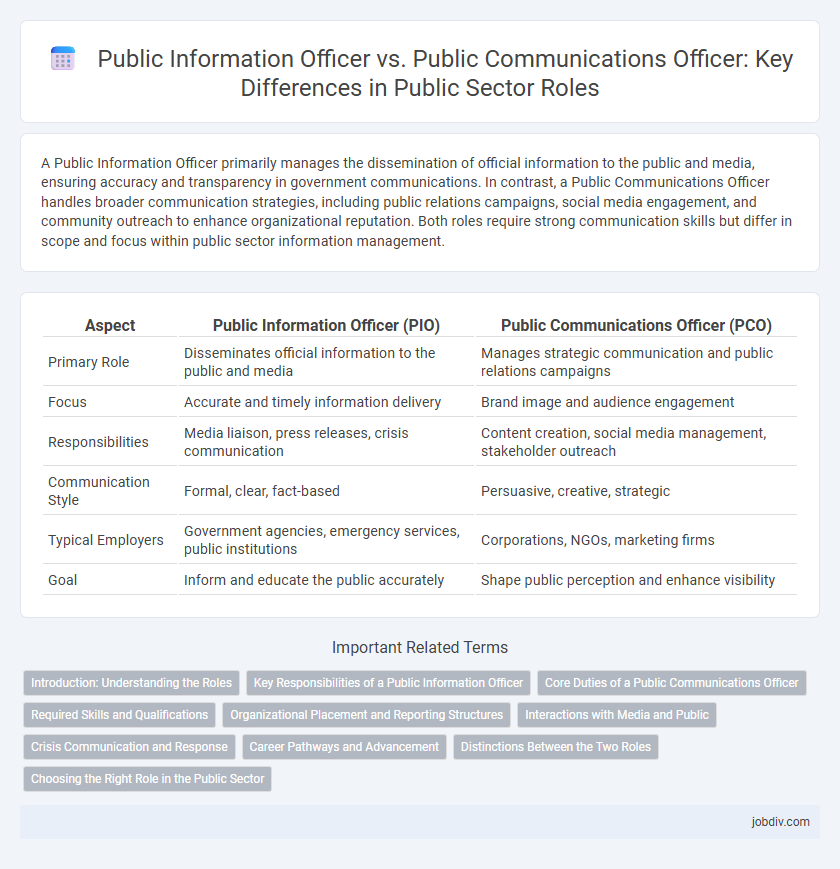A Public Information Officer primarily manages the dissemination of official information to the public and media, ensuring accuracy and transparency in government communications. In contrast, a Public Communications Officer handles broader communication strategies, including public relations campaigns, social media engagement, and community outreach to enhance organizational reputation. Both roles require strong communication skills but differ in scope and focus within public sector information management.
Table of Comparison
| Aspect | Public Information Officer (PIO) | Public Communications Officer (PCO) |
|---|---|---|
| Primary Role | Disseminates official information to the public and media | Manages strategic communication and public relations campaigns |
| Focus | Accurate and timely information delivery | Brand image and audience engagement |
| Responsibilities | Media liaison, press releases, crisis communication | Content creation, social media management, stakeholder outreach |
| Communication Style | Formal, clear, fact-based | Persuasive, creative, strategic |
| Typical Employers | Government agencies, emergency services, public institutions | Corporations, NGOs, marketing firms |
| Goal | Inform and educate the public accurately | Shape public perception and enhance visibility |
Introduction: Understanding the Roles
A Public Information Officer (PIO) primarily manages the dissemination of accurate and timely information to the public and media, ensuring transparency during emergencies or public affairs. A Public Communications Officer (PCO) strategically crafts and delivers organizational messages to shape public perception and enhance engagement across multiple platforms. Both roles are essential for effective communication but differ in focus, with PIOs emphasizing factual reporting and PCOs prioritizing message development and audience targeting.
Key Responsibilities of a Public Information Officer
A Public Information Officer (PIO) is responsible for managing the dissemination of official information to the public and media, ensuring accuracy and transparency in all communications. Key responsibilities include drafting press releases, coordinating media relations, responding to public inquiries, and developing communication strategies during emergencies or public events. Unlike Public Communications Officers who may focus more broadly on marketing and outreach, PIOs specialize in delivering timely, factual information to maintain public trust and support government accountability.
Core Duties of a Public Communications Officer
A Public Communications Officer is primarily responsible for crafting strategic messaging, managing media relations, and coordinating public outreach to enhance organizational reputation. This role includes developing press releases, managing social media platforms, and ensuring consistent brand communication across all channels. Unlike a Public Information Officer, who focuses more on disseminating factual information and handling inquiries, the Public Communications Officer drives proactive engagement and narrative control to influence public perception.
Required Skills and Qualifications
Public Information Officers require strong skills in media relations, crisis communication, and government protocols, often holding degrees in journalism, communications, or public administration. Public Communications Officers emphasize expertise in digital marketing, content creation, and stakeholder engagement, with qualifications typically including marketing, public relations, or communication degrees. Both roles demand excellent verbal and written communication skills, adaptability, and experience with multimedia tools, but the Public Information Officer leans more towards information dissemination under regulatory frameworks, while the Public Communications Officer focuses on brand messaging and audience interaction.
Organizational Placement and Reporting Structures
A Public Information Officer (PIO) typically reports within government agencies or emergency management departments, focusing on disseminating accurate and timely information to the public and media during crises. Public Communications Officers are often placed within corporate communications or marketing departments, tasked with managing an organization's overall public messaging and brand reputation. The hierarchical placement of PIOs usually involves coordination with operational leadership, while Communications Officers report to corporate executives or communication directors.
Interactions with Media and Public
Public Information Officers (PIOs) serve as official spokespersons, providing timely, accurate information to media outlets and managing press conferences to ensure consistent messaging. Public Communications Officers (PCOs) handle broader communication strategies, including social media engagement and public outreach campaigns, facilitating two-way interactions with both the media and the general public. Both roles require strong media relations skills, but PIOs focus more on formal press interactions while PCOs emphasize ongoing public engagement and digital communication.
Crisis Communication and Response
Public Information Officers (PIOs) specialize in crisis communication by delivering timely, accurate information to the public and media during emergencies, ensuring transparency and trust. Public Communications Officers manage broader communication strategies, including media relations and public messaging, but may support crisis response through coordinated messaging and stakeholder engagement. Effective crisis communication demands the PIO's expertise in rapid information dissemination and maintaining public confidence under pressure.
Career Pathways and Advancement
Public Information Officers (PIOs) often advance by specializing in media relations, crisis communication, and government agency roles, leveraging expertise in accurate information dissemination to the public. Public Communications Officers (PCOs) typically pursue career growth through broader strategic communication roles, including marketing, internal communications, and public affairs, enabling transitions into corporate or nonprofit sectors. Both career pathways offer progression to senior communication director roles, with PIOs focusing more on public sector and emergency communication leadership.
Distinctions Between the Two Roles
A Public Information Officer (PIO) primarily manages the release of official information to the public and media, ensuring accuracy and transparency during emergencies or public affairs. In contrast, a Public Communications Officer focuses on crafting strategic messaging and managing outreach campaigns to shape public perception and engagement across various platforms. The distinction lies in the PIO's role in disseminating timely, factual updates versus the Communications Officer's responsibility for broader public relations and marketing efforts.
Choosing the Right Role in the Public Sector
A Public Information Officer (PIO) primarily manages government information dissemination, ensuring transparency and compliance with legal requirements, while a Public Communications Officer focuses on crafting strategic messaging and engaging with diverse audiences through multiple media channels. Selecting the right role depends on organizational needs: choose a PIO when priority lies in regulatory communication and crisis management, and opt for a Public Communications Officer to enhance public relations and build community trust. Both roles require strong communication skills but differ in scope and focus, making role clarity essential for effective public sector communication strategies.
Public Information Officer vs Public Communications Officer Infographic

 jobdiv.com
jobdiv.com